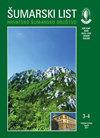Determination of some phenolic substances in six different populations of turkish hazel (Corylus colurna L.) leaves and comparison of phenolic fluctuation with water deficiency
IF 0.4
4区 农林科学
Q4 FORESTRY
引用次数: 0
Abstract
Turkish hazel (Corylus colurna L.) is one of the naturally grown hazelnut species in Turkey. It can be easily separated from other hazel species with its thick single stem and tall appearance. It can be used in afforestation and erosion control studies due to low demand for habitat and strong root system. It contains substances with high medicinal value in its fruits and leaves. Hazel leaves have strong antioxidant activity due to their high phenolic content. Objective of the study was primarily to determine the individual phenolic constituents of six different population of Turkish Hazelnut and then to evaluate the effect of water deficiency stress generated by irrigation regime on phenolic constituents and photosystem II activity on these genotypes. Grafted plants were produced by taking scions from six different populations of Turkish Hazelnut (Oğuzlar, Erenler, Merkeşler, Seben, Güney Felakettin and Pelitcik). The study was started when the grafted seedlings were 7 years old in greenhouse. During the experiment (June and July), two different levels of irrigation were applied (W1: the soil was fully irrigated to reach field capacity in each irrigation; W2: 50% reduction of W1 irrigation water). After the application of two different irrigation regimes, leaves were collected for each month, dried, extracted with methanol and then quantitatively analyzed and compared for individual phenolic constituents (gallic acid monohydrate, caffeic acid, rutin hydrate, luteolin-7-O-β-D glucoside, kaempferol, rosmarinic acid, myricetin, quercetin, coumarin and apigenin) by using high performance liquid chromatography (HPLC) coupled with a diode array detector (DAD). Generally, rutin, kaempferol and luteolin were dominant individual phenols in methanol extracts of Turkish hazelnut leaves. Pelitcik population was noticeable source of rutin and kaempferol in June, and the halved irrigation regime significantly increased the levels of both phenols in July. Similarly, the highest total phenolic content was observed in the Pelitcik population in June and the halved irrigation regime significantly increased the total phenolic content in both months in this population. It was also determined to what extent water deficiency physiologically affects the quantum efficiency (Fv/Fm) of photosystem II activity through chlorophyll fluorescence technique in hazelnut leaves. Generally, Fv/Fm value decreased with water deficiency. This study showed that water deficiency stress generally caused an increase in phenolic constituents in Turkish Hazel leaves and they may be proper natural sources of phenolic constituents with abiotic stress applications in pharmaceutical and food industry.土耳其榛子(Corylus colurna L.) 6个不同居群叶片中部分酚类物质的测定及水分缺乏时酚类物质波动的比较
土耳其榛子(Corylus colurna L.)是土耳其天然生长的榛子品种之一。它可以很容易地从其他榛子品种中分离出来,它的粗单茎和高的外观。由于对生境要求低,根系结实,可用于造林和水土流失防治研究。它的果实和叶子含有具有很高药用价值的物质。榛叶中酚类物质含量高,具有较强的抗氧化活性。本研究的主要目的是测定6个不同土耳其榛子群体的酚类成分,然后评估灌溉制度引起的缺水胁迫对这些基因型的酚类成分和光系统II活性的影响。从6个不同的土耳其榛子群体(Oğuzlar, Erenler, merke, Seben, g ney Felakettin和Pelitcik)中提取接穗,获得嫁接植株。本研究是在温室中嫁接幼苗7岁时开始的。试验期间(6月和7月),施用2种不同水平的灌溉(W1:每次灌溉充分灌溉土壤达到田间容量;W2:灌溉水W1减少50%)。采用两种不同的灌溉方式后,每个月收集叶片,干燥,甲醇提取,然后使用高效液相色谱(HPLC)耦合二极管阵列检测器(DAD)定量分析和比较单个酚类成分(没食子酸一水、咖啡酸、水合芦丁、木犀草素-7- o -β-D葡萄糖苷、山奈酚、迷迭香酸、杨梅素、槲皮素、香豆素和芹菜素)。一般来说,芦丁、山奈酚和木犀草素是土耳其榛子叶甲醇提取物中占优势的单体酚。6月,培利克种群是芦丁和山奈酚的显著来源,7月,减半灌溉制度显著提高了这两种酚的含量。同样,6月份培利特克种群的总酚含量最高,而减半灌溉制度在这两个月份显著提高了该种群的总酚含量。利用叶绿素荧光技术测定了缺水对榛子叶片光系统II活性量子效率(Fv/Fm)的生理影响程度。一般情况下,Fv/Fm值随水分缺乏而降低。本研究表明,水分缺乏胁迫一般会导致土耳其榛子叶片中酚类成分的增加,它们可能是具有非生物胁迫应用于制药和食品工业的酚类成分的天然来源。
本文章由计算机程序翻译,如有差异,请以英文原文为准。
求助全文
约1分钟内获得全文
求助全文
来源期刊

Sumarski List
FORESTRY-
CiteScore
0.90
自引率
20.00%
发文量
32
审稿时长
>12 weeks
期刊介绍:
Forestry Journal publishes scientific and specialist articles from the fields of forestry, forestry-related scientific branches, nature protection and wildlife management.
 求助内容:
求助内容: 应助结果提醒方式:
应助结果提醒方式:


